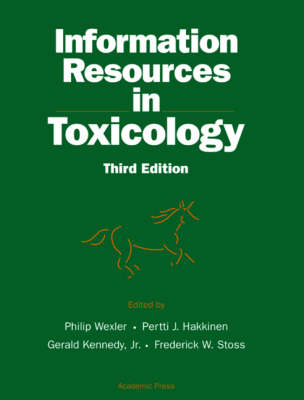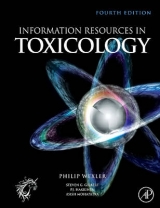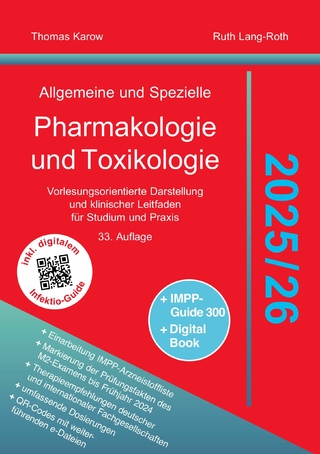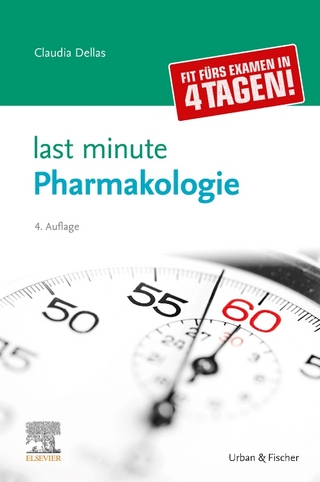
Information Resources in Toxicology
Academic Press Inc (Verlag)
978-0-12-744770-4 (ISBN)
- Titel erscheint in neuer Auflage
- Artikel merken
Information Resources in Toxicology, Third Edition is a sourcebook for anyone who needs to know where to find toxicology information. It provides an up-to-date selective guide to a large variety of sources--books, journals, organizations, audiovisuals, internet and electronic sources, and more. For the Third Edition, the editors have selected, organized, and updated the most relevant information available. New information on grants and other funding opportunities, physical hazards, patent literature, and technical reports have also been added.This comprehensive, time-saving tool is ideal for toxicologists, pharmacologists, drug companies, testing labs, libraries, poison control centers, physicians, legal and regulatory professionals, and chemists.
Philip Wexler has written and edited numerous publications related to toxicology and toxico-informatics, as well as taught and otherwise lectured globally on these topics. He has been Editor-in-Chief of Elsevier’s Encyclopedia of Toxicology including the current, 4th edition (2023) since its inception as well as Information Resources in Toxicology (Elsevier. 5th ed. 2020), and Chemicals, Environment, Health: A Global Management Perspective (CRC Press/Taylor and Francis. 2011). He has served as Associate Editor for Toxicology Information and Resources for Elsevier's journal, Toxicology and edited special issues on Digital Information and Tools. Phil is also overseeing a monographic series on Toxicology History. Volumes have been published on Antiquity, the Middle Ages and Renaissance, modern clinical toxicology, risk assessment, alternative test methods, food and nutrition, and disasters, with more in the planning stages. He is a co-Editor-in-Chief of the Taylor and Francis journal, Global Security: Health, Science, and Policy and a past recipient of the US Society of Toxicology’s (SOT) Public Communications Award. Phil recently retired from a long federal career as a Technical Information Specialist at the National Library of Medicine’s (NLM) Toxicology and Environmental Health Information Program, within its Specialized Information Services Division (SIS). His initial position at NLM was as a Fellow of its Associate Program and early work included a brief stint in the Reference Services Section. A recipient of the NLM Regents Award for Scholarly or Technical Achievement and the Distinguished Technical Communication Award of the Washington chapter of the Society for Technical Communication, he was team leader for the development of the ToxLearn online multi-module tutorials, a joint activity with the SOT. Phil had also been project officer for the LactMed file on drugs and lactation, and the IRIS (Integrated Risk Information System) and ITER (International Toxicity Estimates for Risk) risk assessment databases. Additionally, Phil had been the guiding force behind, and federal liaison to, the World Library of Toxicology, Chemical Safety, and Environmental Health (WLT) prototype, a free global Web portal that provided the scientific community and public with links to major government agencies, non-governmental organizations, universities, professional societies, and other groups addressing issues related to toxicology, public health, and environmental health prior to its migration to the INND/Toxipedia group. This multilingual tool, fed by information from a roster of international Country Correspondents, has been praised as a successful test resource for overcoming barriers to the sharing of information between countries, enhancing collaboration, and minimizing duplication. Currently on hiatus, it awaits a visionary funding source to become operational. A trustee of the Toxicology Education Foundation (TEF), Phil had previously served as its federal liaison. He is a past Chair of SOT’s World Wide Web Advisory Team, and active in its Ethical, Legal, Forensics, and Social Issues Specialty Section. He was a member of the Education and Communications Work Group of the CDC/ATSDR’s National Conversation on Public Health and Chemical Exposure. A co-developer of the Toxicology History Room, he is co-founder and was federal liaison to the Toxicology History Association. For many years he organized and emceed the popular Toxicology Quiz Bowl at the annual SOT meetings. In addition to pursuing toxicology-related activities in his retirement, Phil is happy to have more time to embrace other lifelong interests. He is the author of five poetry collections, a mosaic artist, and a cactus and succulent enthusiast.
History: - K.D. Watson, P. Wexler, and J. Everitt.
Highlights in the History of Toxicology.
Selected References in the History of Toxicology.
A Historical Perspective of Toxicology Information Systems.
Books and Special Documents: - G.L. Kennedy, Jr., P. Wexler, N.S. Selzer, and L.A. Malley.
General Texts.
Analytical Toxicology.
Animals in Research.
Biomonitoring/Biomarkers.
Biotechnology.
Biotoxins.
Cancer.
Chemical Compendia.
Chemical--Cosmetics and Other Consumer.
Products.
Chemical--Drugs.
Chemical--Dust and Fibers.
Chemical--Metals.
Chemicals--Pesticides
Chemicals--Solvents.
Chemical--Selected Chemicals.
Clinical Toxicology.
Developmental and Reproductive Toxicology.
Environmental Toxicology--General.
Environmental Toxicology-- Aquatic.
Environmental Toxicology--Atmospheric.
Environmental Toxicology--Hazardous Waste.
Environmental Toxicology--Terrestrial.
Environmental Toxicology--Wildlife.
Epidemiology.
Food and Nutrition.
Forensic.
Genetic Toxicology.
Molecular, Cellular, and Biochemical Toxicology.
Noise.
Occupational Health.
Pathology.
Pharmacokinetics and Metabolism.
Radiation.
Regulatory Toxicology.
Risk Assessment.
Target Sites--General.
Target Sites--Cardiovascular.
Target Sites--Endocrine.
Target Sites--Gastrointestinal.
Target Sites--Hematopoietic.
Target Sites--Immune.
Target Sites--Kidney.
Target Sites--Liver.
Target Sites-- Nervous System.
Target Sites--Respiratory.
Target Sites--Sensory.
Target Sites--Skin.
Testing Methods and Toxicity Assessment (Including Alternatives).
Veterinary Toxicology.
Miscellaneous.
Journals: - P. Wexler.
Journal Listings.
Additional Journals Carrying Relevant Articles.
Newsletters: - P.J. Hakkinen and F.W. Stoss.
Introduction.
General Newsletter Publications and Internet Sites.
On-Line Sources of Full-Text Coverage.
Listing of Newsletters.
General Interest and Popular Works: - F. W. Stoss.
Compendia.
General Interest and Popular Works.
Internet and Other Digital Resources: - P. Wexler, P.J. Hakkinen, and F.W. Stoss.
Web Sites.
Browsers.
Search Tools.
Mailing Lists.
Newsgroups.
Electronic Bulletin Board Systems (BBSs).
Computer Databases.
U.S. EPA Software and Applications for Hazardous and Toxic Materials.
Databases and Software Afterword.
Print Bibliographic Resources: - L.M. Poore.
Technical Reports and Government Documents: - F.W. Stoss.
Federal Government Technical Reports.
State and Local Government Technical Reports.
Industry-Sponsored Technical Report Literature.
Examples of Toxicology Technical Reports.
Other Government Documents.
Publishers: - L.M. Poore and T.L.B. Wilson.
Audiovisuals and Non-print Media Resources: - F.W. Stoss and K. Deck.
Audiovisual Resources Titles.
Audiovisual Materials--Procedures and Distributors.
Toxicology Data and Information Management: - F.W. Stoss and P. Wexler.
Periodicals.
Databases.
Bibliography.
Overview of U.S. Chemical and Environmental Control Laws and Regulations and Helpful Information Sources: - M. Bandurraga.
Tracking Publications.
Training Courses.
Regulation of Chemicals in the United States: - M. Bandurraga.
The U.S. Regulatory Process.
Public Access to Data and the U.S. Regulatory Process.
Regulatory Authorities for U.S. Chemical Control.
Positive List Approach.
Registration Process to Add Chemicals to the List
Notification Process.
History of Federal Chemical Control Laws and Agencies.
Impacts on Toxicologists of U.S. Laws and Regulations.
Current U.S. Chemical Regulatory Issues.
Resources for Hazard Communication Compliance: - D. Marsick and P. Dsida.
MSDS Collections.
MSDS References.
MSDS Construction.
MSDS Consultants.
International Harmonization.
Electronic Data Banks.
Detailed Addresses.
Organizations: - P.J. Hakkinen, F.W. Stoss, B. Behrendt, and P. Wexler.
Directories for Locating State, County, and Local Sources.
How to Find Additional Organizations.
Listing of Organizations.
Special Groups.
Education:
Introduction.
Resource Guide to Careers in Toxicology (Prepared by the SOT).
Graduate Programs in Environmental Chemistry, Environmental Engineering, and Environmental Toxicology (Prepared by the SETAC).
Grants and Other Funding Opportunities: -
F.W. Stoss and P. Wexler.
Reference Books.
Online Searchable Databases.
Selected Internet Resources.
Electronic Journals and Newsletters.
Web Sites and/or E-mail Addresses.
Endnote.
Toxicology Testing Methods and Laboratories: - P.J.Hakkinen.
In Vitro and Other Toxicology Testing Methods and Teaching Aids: Sources of Information.
Toxicology Testing Laboratories.
Environmental Testing Laboratories.
Poison Centers Certified.
American Association of Poison Control Centers.
Assessment of Physical Hazards: - P.J. Hakkinen
Organizations and Internet Locations.
Bibliography of Guidance and Research Publications Related to Physical Hazards.
Patents: Toxicological Information Resource: - R.O. Beauchamp, Jr..
Sources of Patent Information.
Summary.
Overview of International Activities: - C.E. Cowan-Ellsberry, M.J. Irwin, and C.C. Lally.
Historic Drivers for Toxicology and Toxicology Information Dissemination.
Roles of International Organizations.
International Assessment of Chemical Risks.
Classification and Labeling.
Information Exchange.
Risk Reduction Programs.
Strengthening National Capabilities.
Prevention of Illegal Traffic.
Future Directions.
International Register of Potentially Toxic Chemicals:
North America.
Latin America and the Caribbean.
Europe.
West Asia.
Asia and the Pacific.
Africa.
Member Societies of the International Union of Toxicology (IUTOX):
International Union of Toxicology.
Countries:
Canada: E.M.K. Lui, C.A.M. Suzuki, and J.R. Bend.
China: S. Li and D.Y. Zhu.
Egypt: L.A.M. Abd El-Megid and E.-S.M. Salem.
Finland: H. Komulainen.
France: J. Descotes.
Germany: R. Kahl and H. Desel.
India: S. Sharma, S.N. Agarwal, and P.K. Seth.
Italy: P. Preziosi, A. Dracos, and I. Marcello.
Japan: T. Satoh.
The Netherlands: G.J. Mulder.
Norway: R. Wiger and E. Dybing.
Russia: B.A. Kurlyandski and K.K. Sidorov.
Spain: M. Repetto.
Sweden: E.M. and G. Heurgren.
Taiwan: J.-K. Lin.
United Kingdom: C. Steed and C. Hartley.
Uruguay: M. Burger.
Appendices:
Glossary of Terms Used in Toxicology (IUPAC Recommendations 1993).
Career Opportunities in Toxicology.
Toxicological information system from SciVision, TOXSYS.
| Erscheint lt. Verlag | 10.1.2000 |
|---|---|
| Mitarbeit |
Chef-Herausgeber: P.J. Bert Hakkinen |
| Verlagsort | San Diego |
| Sprache | englisch |
| Maße | 216 x 279 mm |
| Gewicht | 2490 g |
| Themenwelt | Schulbuch / Wörterbuch ► Lexikon / Chroniken |
| Studium ► 2. Studienabschnitt (Klinik) ► Pharmakologie / Toxikologie | |
| Naturwissenschaften ► Biologie ► Biochemie | |
| ISBN-10 | 0-12-744770-9 / 0127447709 |
| ISBN-13 | 978-0-12-744770-4 / 9780127447704 |
| Zustand | Neuware |
| Informationen gemäß Produktsicherheitsverordnung (GPSR) | |
| Haben Sie eine Frage zum Produkt? |
aus dem Bereich



